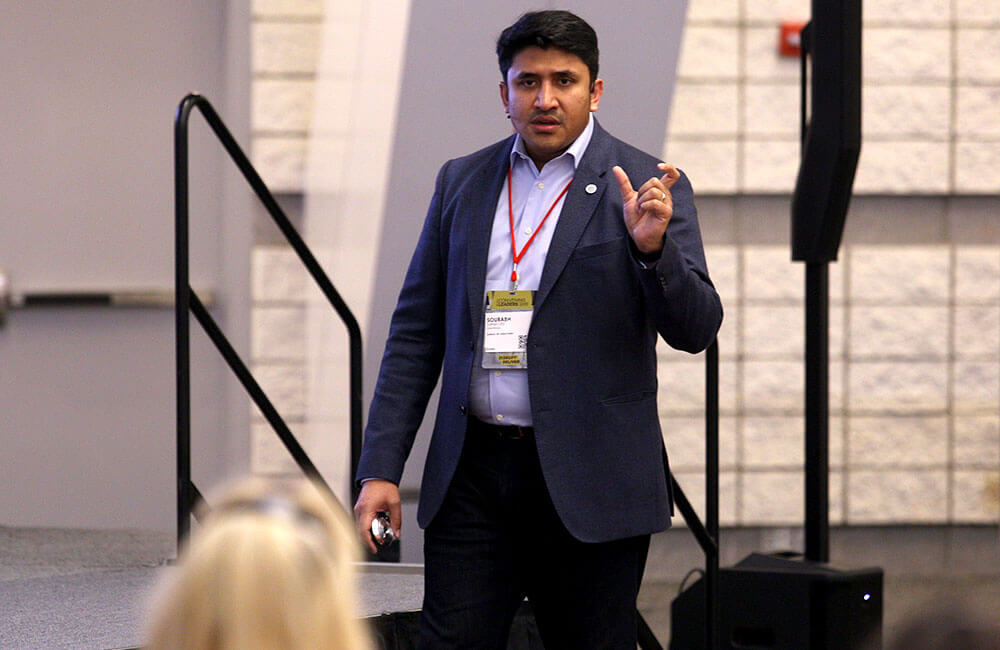
Sourabh Kothari, CEO and co-founder of IntentWave, presents his “Applying Lessons From Neuroscience to Enrich Event Storytelling” session at Convening Leaders 2019. (Jacob Slaton photo)
Is offering a packed program schedule — tracks upon tracks, multiple sessions held at the same time, and with one on top of the next so there’s little time for breaks — your best way to demonstrate ROI for your attendees? You may think that you are giving participants the widest possible choice in terms of what they want to learn, but two Convening Leaders 2019 session speakers shared why that kind of program actually detracts from the learning experience.
Overscheduling drains your brain, said Dee O’Neill, MS, LPC, BCN, head of executive and corporate programs at the Brain Performance Institute at the Center for BrainHealth, under the umbrella of The University of Texas at Dallas. At her session, “Using Neuroscience to Enrich Storytelling,” O’Neill discussed what neuroscience researchers have learned about the brain’s executive or frontal lobe, which oversees our complex problem solving, innovative thinking, emotional intelligence, mental flexibility, judgment, and decision-making functions.

Dee O’Neill
Those are the cognitive functions we want to spark at our conferences. “It is our brain’s CEO, or ‘Cognitive Executive Officer,’” O’Neill said. Once you understand the brain’s chemistry, you can learn what drives and drains it, she said.
The other three things that drain your brain? Feeling unproductive, deep-thought deprived, and cruising on autopilot. “The culprit is information overload and there are strategies to combat each,” she said.
A main cause of overload is stress, said O’Neill. Something as simple as reading a slide with too much text on it can cause overload. “We tend to over-select information, so we can filter better, so often simpler is better. Stress makes you stupid, it can literally destroy brain cells. We want to be optimally engaged, but not saturated. That’s what we call the sweet spot of stress,” she said.
Looking at your phone screen (an average of 150 times a day is the stat she used) is a distraction, which means your brain is not optimized and leads to deep-thought deprivation. The brain is not built to multi-task, she said, squashing the myth for those that thought it was an asset professionally. “Suggest to your session attendees to leave their phones at the door,” O’Neill said.
Helping your brain manage all the incoming information is the best way to get the most out of it, O’Neill said. She recommended that attendees narrow down the top two pieces of information they picked up at her session — two they could take away and act on. “Use that throughout this conference,” she told the attendees. And then do the same with your conferences. “What are the top two things you want your participants to leave with from your conferences?”
Tell Stories
One way to drive positive changes in the brain is through storytelling, O’Neill said. That’s where Sourabh Kothari, CEO and co-founder of IntentWave, picked up the following day at the “Applying Lessons From Neuroscience to Enrich Event Storytelling” session.
Using O’Neill’s neuroscience insights as a foundation, Kothari established that the ultimate goal of learning during events is for participants to change their behavior. He reinforced that cramming content into a program is not optimal for conference-goers. “From an attendee’s perspective, more is not better,” Kothari told the audience.
“How does an attendee value your event?” he asked. It’s not “the dollar spent,” he said. “They want a perfectly curated event. ‘How did I spend my time during those two to three days, and for each day, what were the three to five memorable events?’”
Thoughtful curation trumps choice overload when it comes to helping participants retain content, and engaging all five of their senses is a way to create memories, Kothari said. “It elevates retention, uses more of your brain, and triggers associated memories. Neurons that fire together, wire together. When we make connections in our brains, we look for other things to connect with. If we don’t make connections with something that is already important to us, it doesn’t resonate.” In planning learning events, it is critical to understand your attendees’ top priorities and build them as the cornerstone of your education, he said.
Kothari recommended using storytelling to make those memories stick. That entails crafting your agenda design as a narrative, with a hero, supporting cast, and an ending that sticks. Start at the beginning, he suggested. What is the objective of a keynote? “Too many have become about shock and awe,” he said. “The purpose of a keynote is to establish the main character in your event’s story, which is the future version of your attendee.”
Your keynoter should be someone that believes more in the attendees than they do in themselves — a kind of a life coach, Kothari said, someone who can be a promise of one’s future self to the attendee. He used as an example Convening Leaders’ keynoter Seth Godin, who impressed attendees with his empathy: “He genuinely cares about your welfare,” he said. Kothari added that your attendees can quickly spot the fakes. He reiterated that keynoters don’t have to be the “wow figure,” which might offer a short-term dopamine fix, but which doesn’t allow for lasting memories in which they learned something.
Your breakouts are a continuation of the narrative your keynote started. “You need a supporting cast and supporting characters, which are often speakers who are veterans at what they do, not necessarily who know the content best,” Kothari said.
An important piece of the story is to help people learn together rather than alone. “Right now, “ he said, your audience wants “to learn together a lot more, because we are very fragmented as a species. We are not making time to connect with each other.”
The fallback solution to together time is networking breaks, but Kothari said that’s not enough. “The answer is not ‘we do a happy hour,’” he said. “The fear of doing something new is easier when you are connected. It’s best to try new things together.” This applies to nontechnical fields. He recommended that in every session, except for the keynote, attendees should be asked to apply what they are learning.
“All it takes is five minutes to prioritize: ‘This is the problem.’ You must develop empathy. If you have empathy, even for the adversary, you have the trust of the audience,” Kothari said. “They have to be the one who solves the problem. In particular, your closing presenters need to nail leading them to this best new version of themselves moving forward.”
Betsy Bair is vice president, strategic narratives, at Velvet Chainsaw Consulting.
